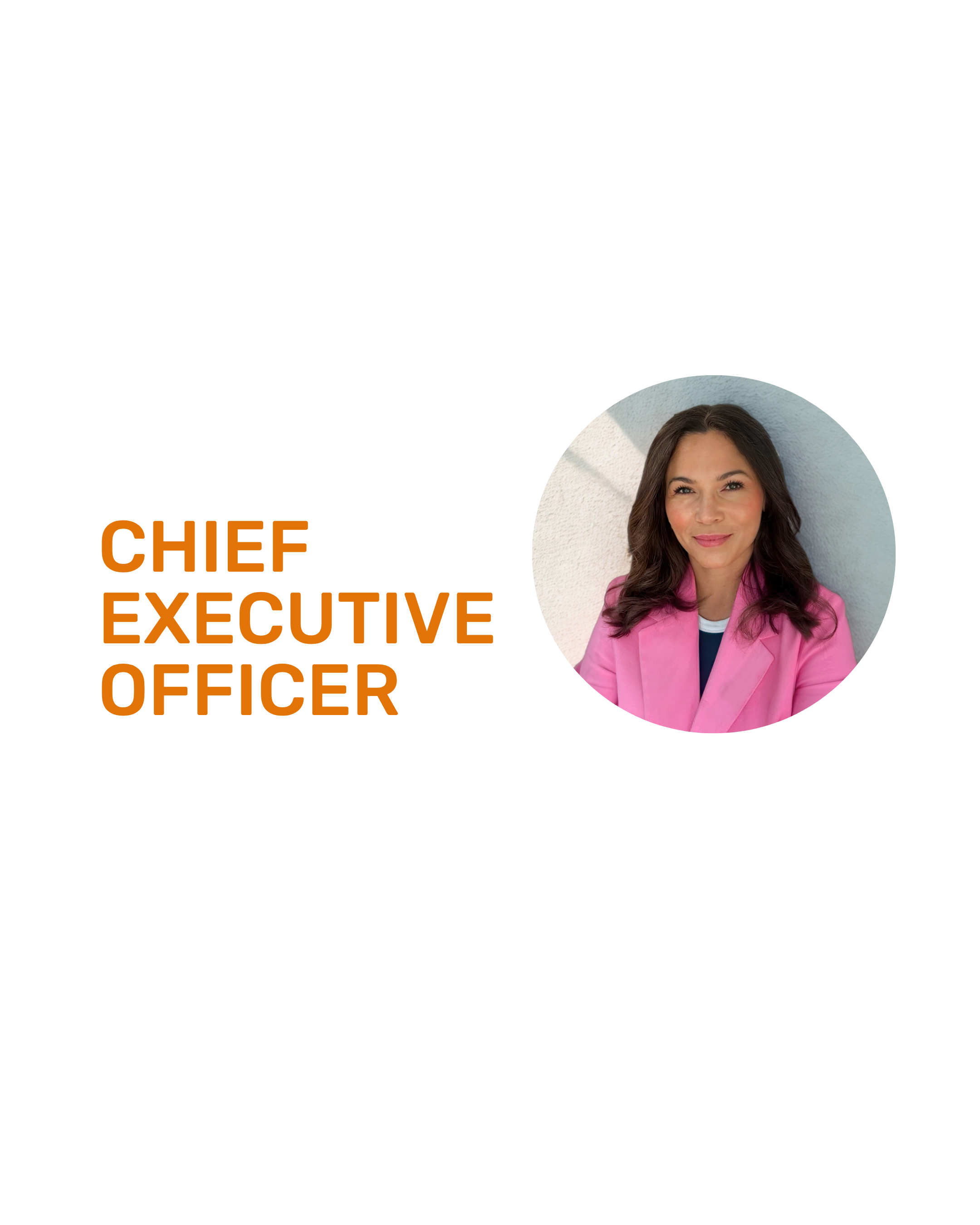Q&A with Healthy Futures of Texas’ new CEO Ginger Mullaney
1) What are your priorities as the new CEO of HFTX?
As the new CEO of Healthy Futures of Texas, one of my top priorities is making sure young people and their communities are not just heard, but truly listened to. Their voices should shape our work, and I’m committed to ensuring our programs reflect the diversity of the communities we serve across Texas.
I’m also focused on building strong, meaningful partnerships with local leaders, nonprofits, businesses, and schools so that together, we can create a stronger network of support for youth. With so many social supports in flux right now, especially for young people and families, it’s more important than ever to work hand-in-hand with other youth-serving organizations. Whether it’s in healthcare, education, or social services, collaboration is key to making sure every young person has what they need to thrive.
2) How has your background prepared you for your new role?
My journey to this role is deeply personal. I grew up in neighborhoods that many would label as low-income or “at-risk,” so I know firsthand how powerful it can be when young people have access to the right resources and support. I was one of those kids who benefited from youth programs that introduced me to art, music, languages, and travel experiences, which helped build my confidence and character. They pushed me to imagine a future beyond the limits of my zip code.
Looking back, I’ve realized just how common unplanned pregnancy was in my circles growing up. In the class just ahead of mine—less than twenty seniors—seven experienced unplanned pregnancies before graduation. And in high school, conversations about pregnancy scares were just part of everyday life. By the time we were 20, many people I knew had navigated an unplanned pregnancy. Some had amazing support systems and found ways to keep moving forward, but the reality is that many struggled. We know that balancing school, work, and parenting can be overwhelming, and too often, it derails a young person’s goals.
Those early experiences shaped me. The youth programs and mentors who believed in me gave me a foundation to pursue college, build a career, and move forward with purpose. That’s why this work means so much to me. I know what a difference support and opportunity can make. I’m passionate about helping young people and their families access the tools and resources they need to thrive, because I’ve lived the difference it can make.
3) How will you continue to evolve HFTX’s partnerships with schools, health providers, and policymakers to support the organization’s mission?
At Healthy Futures of Texas, our mission is all about improving the well-being of young Texans by making sure they have access to quality sexual health education, resources, and contraception. But over the years, I’ve learned that there’s no one-size-fits-all approach—every community is different, and real impact starts with meeting people where they are.
That means recognizing the unique realities of each community and taking the time to support growth from whatever their starting point may be. Sometimes, it’s about helping someone shift their perspective just slightly–through tools, training, and conversation–so they feel empowered to take the next step.
That’s why I’m committed to strengthening and expanding our partnerships with schools, healthcare providers, and policymakers. These relationships must be grounded in local realities and built on trust, flexibility, and shared goals.
Our five-pillar approach guides this work by bringing together voices from across sectors—including youth and caregivers—to co-create solutions that are responsive, relevant, and grounded in lived experiences.
This is a natural evolution from where we started as an organization. We’re becoming more collaborative, more community-informed, and more focused on building systems that truly support youth. I’m excited to keep that momentum going.
4) What are the biggest challenges for HFTX moving forward?
One of the biggest challenges we’re facing right now is how rapidly everything is shifting—resources, systems, and expectations. Public health and social services have always had to adapt, but lately, it feels like the ground is constantly moving under our feet. It’s like we’re flying a plane while still building it—and then halfway through, someone tells us the parts we need aren’t coming.
At Healthy Futures of Texas, we take pride in being strong and reliable partners. We’re thoughtful and intentional in how we show up for schools, providers, and community leaders. But the truth is, many of them are under a lot of stress too, juggling their own challenges and shifting priorities. In the short term, staying top of mind can be tough when everyone is trying to keep up with so much change.
Looking ahead, we know we’ll need to keep innovating, especially when it comes to reaching youth and families in the digital spaces where they spend their time. The world they’re growing up in looks very different from it did even a few years ago, and we’re committed to evolving alongside them. It’s not easy, but we’re up for the challenge because young Texans deserve nothing less.
5) What are the biggest opportunities for HFTX moving forward?
Our biggest opportunities lie in our biggest challenges.
Innovation: As we learned during the COVID pandemic, we are innovators in times of need. We were able to shift to virtual facilitation, and it actually increased participation in one of our programs over in-person facilitation. During funding rollbacks at the Capitol, we have been successful in reaching across the aisle to support favorable outcomes on the programs we advocate for. As we’ve done before, I am looking to us to innovate.
Technology & Artificial Intelligence: Technological expansion ensures we continue to fill gaps in health education for educators, nonprofits, and families, meeting the needs of Texas youth and communities. I am interested in exploring and understanding the beneficial ways we can use AI to support youth serving professionals and other adult stakeholders who need accurate information about sexual health and healthcare, and identifying safe ways for youth and families to use AI that removes barriers and eliminates mis- and disinformation that can be found on the internet.
Investing in People: Additionally, we understand that our highly trained staff cannot be everywhere and that each community understands its own unique needs. With that, we have the great honor and opportunity to support parents, educators, businesses, faith leaders, and youth-serving professionals in building their capacity to lead these conversations, in their communities, with their employees, in the way that best meets their needs. Part of this investment will include the launch of our new online training portal, HFTX Classroom, for both free and paid users. The portal offers skills in classroom facilitation, puberty and sexual health education, credentials for career advancement, and continuing education credits for various professions.
We are building tools, training, and resources to equip the grown-ups with best practices around conversations about relationships and sex. It’s important these conversations are rooted in community-specific norms, values, policies, and the procedures surrounding them. These resources ensure that our young people are engaging with trained, knowledgeable, safe, and trusted adults who provide them with this information and education. We are excited to partner with communities, as well as local and statewide businesses, on this important work.
6) What are you most excited about in your new role?
I am most excited about building relationships, learning from, and working closely with other community leaders to support and address youth issues. Healthy Futures is one part of the youth ecosystem, and I am highly invested in ensuring we are collaborative and supportive in cross-sector ways that improve those systems. In this new role, I am excited to continue broadening our network and increasing awareness about how Healthy Futures plays an integral role in the youth success ecosystem.
7) How will you build on the legacy of your predecessor, Evelyn Delgado?
Evelyn’s vision and natural ability to connect and cultivate relationships launched Healthy Futures into an epic merger that not only increased HFTX’s impact but also trailblazed a path less traveled by non-profits. As a relational leader, I plan to continue cultivating relationships, building on Evelyn’s legacy while casting a wider net to connect our work to non-traditional stakeholders to equip communities with the confidence and capacity to normalize conversations about sexual health.
8) How would you describe your leadership style?
I am a situational leader. I am decisive and relational, getting there through deep listening, a commitment to intentional collaboration, and fostering relational trust. I value candor and welcome nuance and context because they help me understand how to show up, make sharper decisions, and align direction. Ultimately, it’s all about driving meaningful impact for youth and communities.
My DISC assessment profile is “dominant and conscientious,” a creative personality pattern who is ready to lead, curious, and always eager to break things down and challenge systems to make them better. That said, I’ve learned to lead with the moment and situation in mind. I feel honored to support my brilliant team, walk alongside other leaders, and step up or back to support in the way that is most needed.




